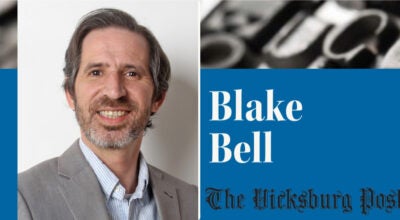Library Column: World War II Adult Nonfiction
Published 8:00 am Sunday, August 29, 2021
This column was submitted by Evangeline Cessna, Local History Librarian at the Warren County-Vicksburg Public Library.
This week’s column features New Adult Nonfiction centered around World War II.
Author David A. Price tells the mesmerizing story of the great minds behind Colossus and chronicles the remarkable feats of engineering that helped to usher in the digital age in his new book “Geniuses at War.” While planning the invasion of Normandy, the Allies knew that decoding the communications of the Nazi high command was essential to their success. Standing in their way was the encryption machine the Brits called Tunny, which was exceedingly more difficult to crack than the infamous Enigma cipher. Alan Turing, the Enigma codebreaker, brought in a maverick working-class engineer named Tommy Flowers to help. Flowers devised the ingenious, daring and controversial plan to build a machine that would calculate at a breathtaking speed and break the code in nearly real-time. Against the odds, the clock and a resistant leadership, Flowers, along with mathematician Max Newman and their team produced Colossus — the world’s first digital electronic computer that would help bring the war to an end.
In “All the Frequent Troubles of Our Days,” Rebecca Donner gives the true account of the amazing life and barbarous death of Mildred Harnack. Harnack was the American leader of one of the largest underground resistance groups in Germany during World War II. Born and raised in Milwaukee, Mildred Harnack was 26 when she enrolled in a Ph.D. program in Germany and witnessed the quick rise of the Nazi party. Determined to do something about the authoritarianism she witnessed, she began holding secret meetings in her apartment. By 1940, her small band of political activists had grown into the largest resistance group in Berlin. Harnack recruited working-class Germans into the resistance, helped Jews to escape, plotted acts of sabotage and collaborated in writing handouts that denounced Hitler and called for revolution. Under cover of night, her coconspirators circulated the materials by slipping them into mailboxes, public restrooms and phone booths. When the first shots of World War II sounded, she became a spy, couriering top-secret intelligence to the Allies. On the eve of her escape to Sweden, she was ambushed by the gestapo and sentenced by a Nazi military court to six years at a prison camp. Hitler, however, overruled the sentence and ordered her executed. On Feb. 16, 1943, Mildred Harnack was strapped to a guillotine and beheaded.
“Operation Barbarossa” by Jonathan Dimbleby tells the compelling story of the largest military operation not only of World War II but of all time — the invasion of Russia by Nazi Germany in 1941. Operation Barbarossa was seen as the turning point of the war in Europe as it turned allies into mortal enemies and triggered the atrocities that characterized the Holocaust. Hitler and other Nazi leaders began planning the invasion of Russia even as the pact with the Soviets was in full force. The invasion would annihilate communism, eradicate inferior races and provide the German people and military with the resources that would ensure both survival and world domination. Barbarossa was a complete fiasco. Between June, when the invasion began, and December 1941, when it stalled, around 6 million men were killed, wounded or listed as missing in action. Both sides committed barbarous acts that few events in the history of warfare could rival. Once the invasion began to falter, Germany was all but guaranteed to lose the war.
Mildred Schindler Janzen tells her remarkable story in “Surviving Hitler, Evading Stalin.” Mildred “Mickchen” Schindler lived the peaceful farm life of a teenage girl when World War II came knocking at the family’s door. Having survived life in Hitler’s Nazi Germany, she and her family faced the terror of a new enemy on the eve of her 16th birthday — Stalin’s Red Army. Mildred and her family were driven from their home and became refugees along with a pitiful, slow-moving caravan of other families who suffered the same fate. At first, Mildred avoids being taken to the work camps like her father, but when Russian soldiers show up unexpectedly, Mildred is taken from her mother and her brothers. She recounts in brilliant detail her treacherous journey and the highs and lows of the raw emotions she feels — fear, regret, loneliness, humility, perseverance and defiance. Her odyssey of making her way home and finding her family in a war-torn country has many twists and turns, but her resilience and fortitude against the odds will inspire anyone to live a life of love and laughter.
Author Giles Milton tells the lively story of the race to seize Berlin in the aftermath of World War II in his book “Checkmate in Berlin.” Berlin’s fate was sealed at the Yalta Conference in 1945. The city, along with the rest of Germany was to be carved up among the victorious powers — the United States, Britain, France and the Soviet Union. On paper, this seems like a practical solution; however, once the four powers were no longer united by the common purpose of defeating Germany, they wasted no time in reverting to their prewar hostility and suspicion of one another. Berlin was to be the most spectacular example of the breakdown of civility between the Western allies and the Soviets. We meet America’s fiery Colonel Frank “Howlin’ Mad” Howley who had a penchant for mischief and an intense dislike of Russians. His wily nemesis was General Alexander Kotikov — commandant of the Soviet sector — who was known for throwing vodka-fueled parties. Howley correctly suspected that Kotikov was Stalin’s agent appointed to evict the Western allies from not only Berlin but ultimately from Germany. This book illustrates the first battle of the Cold War like we’ve never seen it before.






